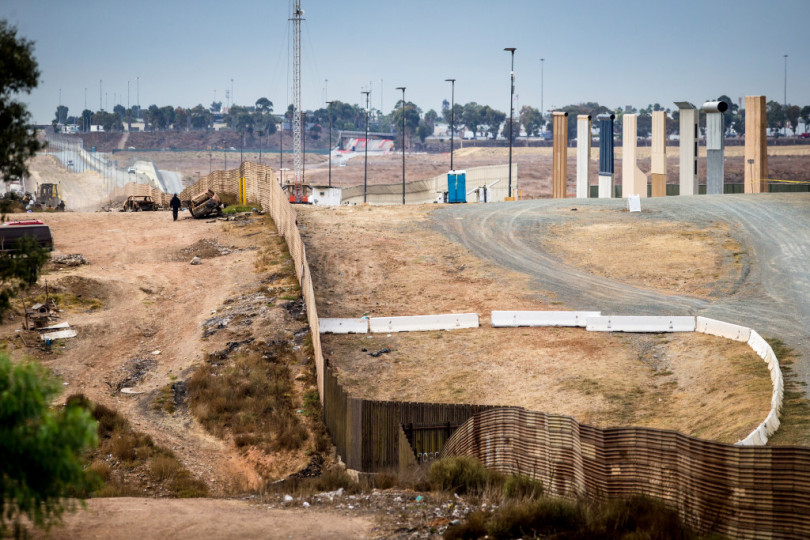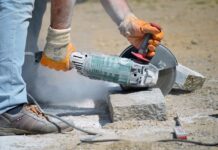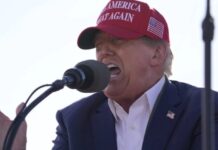President Donald Trump’s “big, beautiful” wall is beginning to take shape with the construction of eight 30-foot prototypes in San Diego, driving intriguing reactions along a section of the border lined with homes, parking lots, dumped waste and burned cars.
The border wall prototypes are in Otay Mesa, a small community south of Diego, along an area of Tijuana where a 10-foot corrugated metal wall already exists. Made of concrete, thick metal poles and other materials, the sample sections were completed a few weeks ago.
One wall has a gray surface textured with patterns of different-sized bricks. A steel plate sits atop the wall with metal spikes. The prototypes are the first tangible signs of a controversial pledge that helped Trump get elected.
Some Tijuana residents say they’re symbols of racism. But others who live a few yards from the prototypes seem indifferent to them. After all, they say, a U.S.-Mexico border wall is nothing new here.
Children and teenagers with backpacks walk past the towering prototypes without even looking up. Many who live a little farther away seem unaware of the eight new structures.
“They don’t bother me,” said Cesar Gonzalez, 60, whose house in Tijuana is adjacent to the prototypes. “If Trump wants to shut in his people, well, he should do it. Here, it doesn’t affect me.”
But Gonzalez, a plant salesman, was skeptical of the wall’s impact. “There are going to be people who will cross by boat, airplane, tunnel, submarine,” he said, adding that in the past five years he’s seen a decrease in the number of people crossing the border near his home.
Like our Facebook page for more conversation and news coverage from San Jose, the Bay Area and beyond.
Maria Elena Valenzuela, 40, who was born in San Diego and grew up on both sides of the Tijuana border, had a stronger reaction to the prototypes. “They’re horrible,” she said.
Valenzuela’s grandfather worked for the railroads in the United States. Her father was a guest worker, or bracero, in California. And she worked as a high school teacher and administrator at schools across California.
“I’m the third generation of Mexicans who work and contribute to that country,” she said, describing the wall as a symbol of ignorance many Americans have toward Mexico. “They don’t recognize our contributions.”
The Otay Mesa prototypes will soon be tested to guide future wall construction, which has not yet been funded by Congress. Workers will wield sledgehammers, torches, pickaxes and battery-operated tools to determine which wall design would best prevent people from breaching the border.
Talking about the wall
The wall was a major point of discussion in the recent “Talking Across Borders” project that used “dialogue journalism” to foster discussions among people with starkly opposing views. The private Facebook group discussion, which included about 60 people from Southern and Northern California, was facilitated by Spaceship Media.
Media partners in the effort included the Bay Area News Group, Southern California News Group and Univision.
Some members of the discussion group felt that the wall would only offer an unrealistic sense of security. But others said it would be beneficial for California to prevent more people from coming in to take jobs and use social services.
Redlands attorney Gregory Brittain, a member of the Redlands Tea Party Patriots who took part in the “Talking Across Borders” project, supports the wall and said the prototypes are “a good height.” He said physical barriers are an important component to halting illegal immigration.
Building the wall just makes sense, Brittain said. It’s a way to protect U.S. citizens from the effects of illegal immigration such as the decrease of wages among low-skilled American workers, he added.
“Just as in your home, you (get) to say who comes into your home,” he said. “As a country, we’re entitled to say who comes into our country.”
But to “Talking Across Borders” participant Mayra Azanza, a 40-year-old entrepreneur who lives in Culver City, a wall would be a “hideous physical statement of a close-minded society.”
Reading this on your phone? Stay up to date with our free mobile app. Get it from the Apple app store or the Google Play store.
“Walls are just placebos,” said Azanza, who came to the U.S. from Mexico on a spousal visa 13 years ago. “As long as there’s a market for cheap labor, drugs, guns and money, there will be smugglers.”
Sending a message
To some border experts, the location of the prototypes sends a powerful political message.
“It’s not just any place along the border. It’s where Mexican and Central American migrants are crossing, where migrants live,” said Oscar Romo, a UC San Diego professor who for years has looked into border infrastructure along San Diego and Tijuana.
It’s a location where government officials likely believe that both migrants and people who live near the border will “look at these prototypes and perhaps be afraid of them,” he said. “It’s been proven before that whatever they do in San Diego has a lot of influence in terms of perceptions both in Mexico and in the U.S.”
The first set of fences made of helicopter landing mats was initially placed along the San Diego-Tijuana border, Romo noted.
“It carries a message that is being seen not just by migrants, but by visitors and tourists, and they carry this message around the world with them,” he said.
Right next to the prototypes in Tijuana is a parking lot where truck drivers from all over Mexico rest and park their trailers after or before delivering goods to retailers south of the border.
Martina Clemente, who runs the parking area’s front office, said she’s seen truck drivers taken aback by the new barriers.
“They look surprised and they take photos,” Clemente said. “They ask themselves, ‘Is this really going to serve a purpose?”’
On a recent afternoon, a 57-year-old man whose last name is Escamilla swept the sidewalk outside his house in Tijuana, with the prototypes looming in the background.
Escamilla didn’t want to give a reporter his first name because he lives and works in the U.S. and said he was afraid of retaliation.
He’s a legal permanent resident in the U.S. and operates a crane for a living. It takes him about an hour-and-a-half to drive from his home in Temecula in Riverside County to visit his family in Tijuana.
“For me, these walls are nothing interesting,” Escamilla said. “I think what this man (Trump) wants to do is divide a country. It’s ignorant. They need us as much as we need them.”





